
Hemaris thysbe, the hummingbird clearwing, is a moth of the family Sphingidae (hawkmoths). Coloration varies between individuals, but typically the moth is olive green and burgundy on its back, and white or yellow and burgundy on the underside. Its wings are transparent with a reddish-brown border. It has light-colored legs, which combined with the lack of striping on the underside is diagnostic. Beating its wings rapidly, H. thysbe hovers to collect nectar from a variety of flowers. The combination of its appearance and its behavior commonly leads to it being confused with a hummingbird or bumblebee.

Arawacus is a genus of butterflies in the family Lycaenidae. They are commonly called stripestreaks. The species of this genus are found in the Neotropical realm.

Camissecla is a genus of butterflies in the family Lycaenidae. The genus was erected by Robert K. Robbins and Marcelo Duarte in 2004. The species of this genus are found in the Neotropical realm.
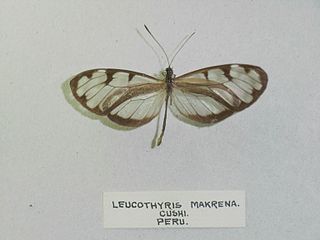
Oleria makrena, the makrena clearwing, is a butterfly of the family Nymphalidae. It is found in Venezuela, Ecuador, Colombia, Bolivia, Peru, Panama and Costa Rica.

Episcada is a genus of clearwing (ithomiine) butterflies, named by Frederick DuCane Godman and Osbert Salvin in 1879. They are in the brush-footed butterfly family, Nymphalidae.

Oleria is a genus of clearwing (ithomiine) butterflies, named by Jacob Hübner in 1816. They are in the brush-footed butterfly family, Nymphalidae.

Oleria gunilla, the Gunilla clearwing, is a species of butterfly of the family Nymphalidae. It is found in Brazil, Ecuador, Colombia and Peru.
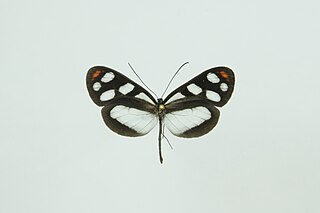
Oleria onega, the Onega clearwing or Onega glasswing, is a species of butterfly of the family Nymphalidae. It is found from Colombia to southern Peru.

Hypothyris is a genus of clearwing (ithomiine) butterflies, named by Jacob Hübner in 1821. They are in the brush-footed butterfly family, Nymphalidae.

Tithorea tarricina, the tarricina longwing, variable presonian, or cream-spotted tigerwing, is a species of butterfly belonging to the family Nymphalidae.

Pseudohaetera hypaesia, the hypaesia satyr, is a butterfly species from the subfamily Satyrinae in the family Nymphalidae.
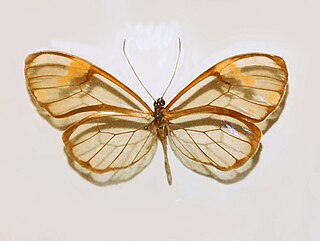
Greta libethris, the Libethris clearwing, is a day active ithomiine butterfly from the subfamily Ithomiinae.

Hyposcada is a genus of clearwing (ithomiine) butterflies, named by Frederick DuCane Godman and Osbert Salvin in 1879. They are in the brush-footed butterfly family, Nymphalidae.
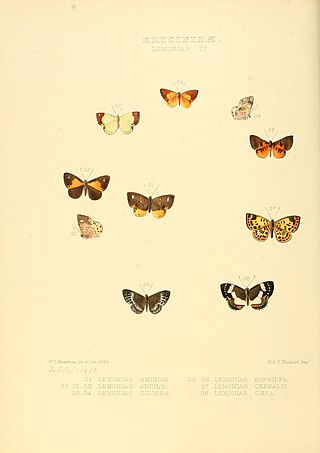
Adelotypa is a genus of butterflies in the family Riodinidae. They are found in South America.
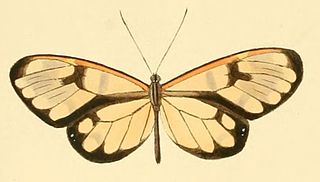
Greta theudelinda is a species of butterfly of the family Nymphalidae. It is found in Colombia, Ecuador, Bolivia and Peru.

Adelpha erotia, the Erotia sister, is a butterfly of the family Nymphalidae. It was described by William Chapman Hewitson in 1847.
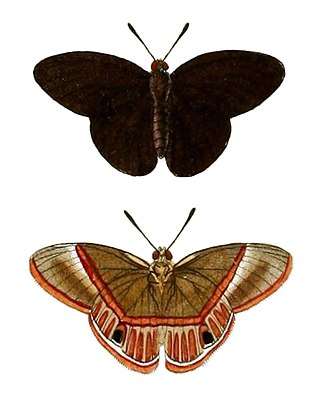
Euselasia is a genus of butterflies in the family Riodinidae. They are present only in the Neotropical realm. The genus was erected by Jacob Hübner in 1819.
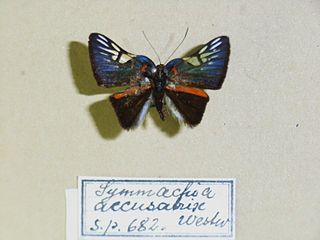
Symmachia is a genus in the butterfly family Riodinidae present only in the Neotropical realm.
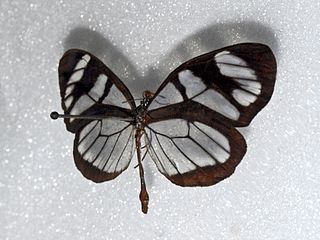
Oleria flora is a species of butterfly of the family Nymphalidae.



















